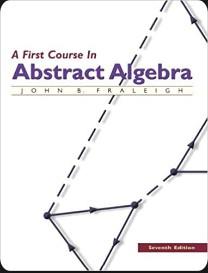Using the last statement in Theorem 46.9, show that for nonzero a, b, n Z, the
Question:
Using the last statement in Theorem 46.9, show that for nonzero a, b, n ∈ Z, the congruence ax ≡ b (mod n) has a solution in Z if a and n are relatively prime.
Data from Theorem 46.9
Let D be a Euclidean domain with a Euclidean norm v, and let G and b be nonzero elements of D. Let r1 be as in Condition 1 for a Euclidean norm, that is, a = bq1 + r1, where either r1 = 0 or v(r1) < v(b). If r1 ≠ 0, let r2 be such that b = r1q2 + r2 where either r2 = 0 or v(r2) < v(r1). In general, let ri+1 be such that ri-1 = riqi+1+ ri+1, where either ri+1 = 0 or v(ri+1) < v(ri). Then the sequence ri, r2, ···must terminate with some rs = 0. If r1 = 0, then b is a gcd of a and b. If r1 ≠ 0 and rs is the first ri = 0, then a gcd of G and b is rs-1. Furthermore, if d is a gcd of a and b, then there exist λ and µ, in D such that d = λa+ µb.
Proof Since v(ri) < v(ri-1) and v(ri) is a nonnegative integer, it follows that after some finite number of steps we must arrive at some rs = 0. If r1 = 0, then a = bq1, and b is a gcd of G and b. Suppose r1 ≠ 0. Then if d|G and d|b, we have d|(a - bq1), So d|r1. However, if d1|r1 and d1|b, then d1|(bq1 + r1), so d1|G. Thus the set of common divisors of a and b is the same set as the set of common divisors of band r1. By a similar argument, if r2 ≠ 0, the set of common divisors of b and r1 is the same set as the set of common divisors of r1 and r2. Continuing this process, we see finally that the set of common divisors of a and b is the same set as the set of common divisors of rs-2 and rs-1, where rs is the first ri equal to 0. Thus a gcd of rs-2 and rs-1 is also a gcd of a and b. But the equation rs-2 = qsrs-1 + rs = qsrs-1 shows that a gcd of rs-2 and rs-1 is rs-1· It remains to show that we can express a gcd d of a and b as d = λa+ µb. In terms of the construction just given, if d = b, then d = 0a + 1b and we are done. If d = rs-1, then, working backward through our equations, we can express each ri in the form λiri-1 + µiri-2 for some λiμi ∈ D. To illustrate using the first step, from the equation rs-3 = qs-1rs-2 + rs-1 we obtain d = rs-1 = rs-3 -qs-1rs-2. We then express rs-2 in terms of rs-3 and rs-4 and substitute in Eq. (1) to express din terms of rs-3 and rs-4. Eventually, we will have
d = λ3r2 + μ3r₁ = λ3(b − r1q2) + µ3r₁ = λ3b + (μ3 - λ3q2)r₁ -
= λ3b + (μ3 - λ3q2)(a - bq₁)
which can be expressed in the form d = λa + µb. If d' is any other gcd of a and b, then
d' = ud for some unit u, so d' = (λu)a + (μu)b.
Step by Step Answer:






